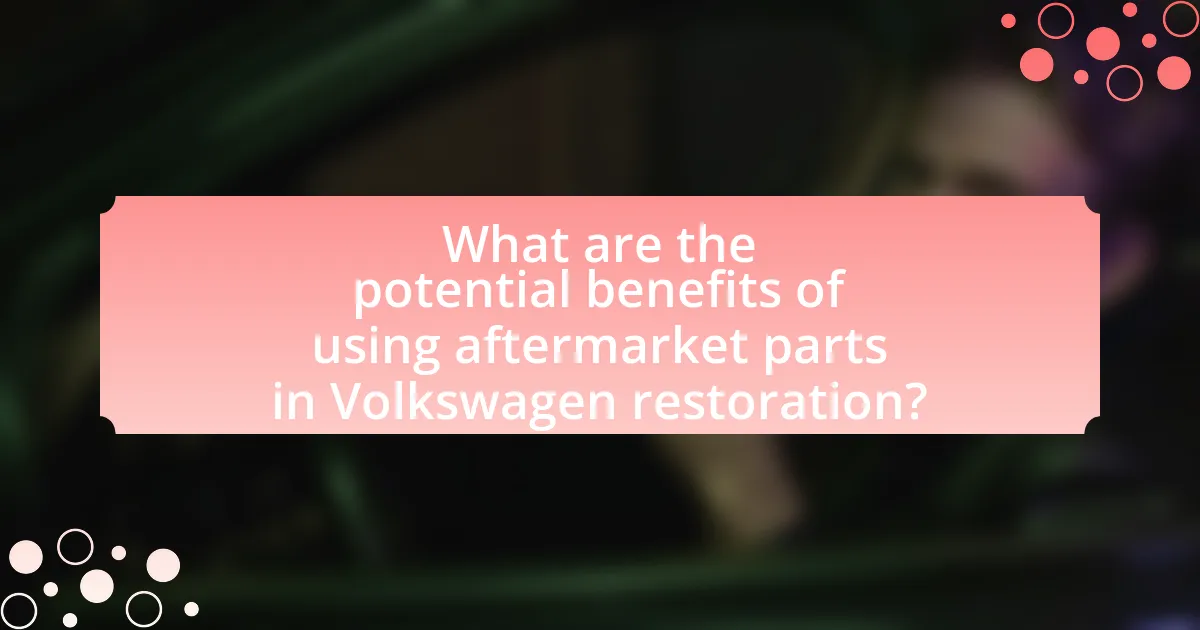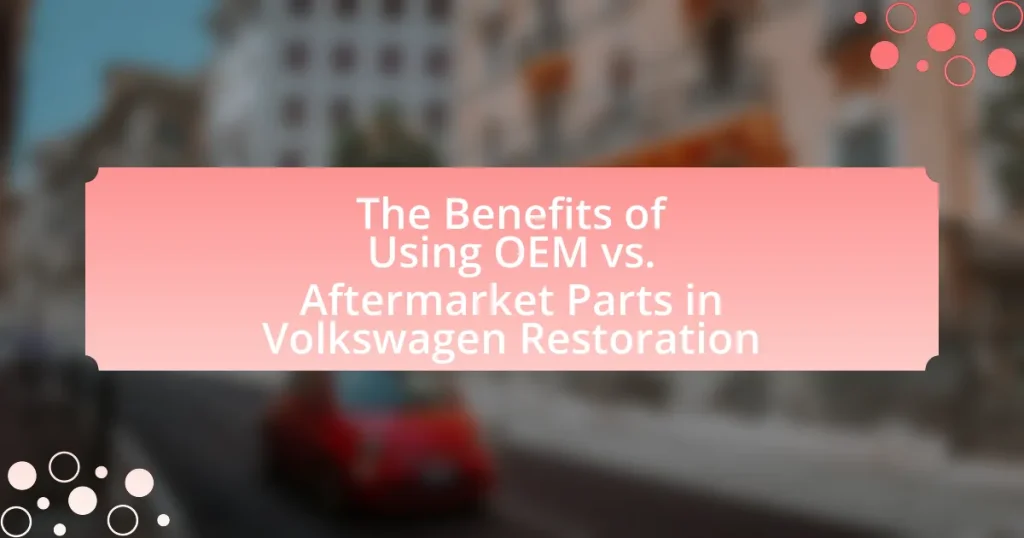The article focuses on the benefits of using OEM (Original Equipment Manufacturer) versus aftermarket parts in Volkswagen restoration. It outlines the key differences between these two types of components, emphasizing that OEM parts are designed to meet the original specifications of the vehicle, ensuring compatibility, reliability, and maintaining the vehicle’s authenticity. In contrast, aftermarket parts, while often more affordable and offering customization options, can vary in quality and may not always fit properly. The discussion includes the impact of these choices on vehicle performance, longevity, resale value, and the importance of selecting the right parts based on restoration goals and budget considerations.

What are OEM and Aftermarket Parts in Volkswagen Restoration?
OEM (Original Equipment Manufacturer) parts are components made by the original manufacturer of the vehicle, ensuring compatibility and adherence to the manufacturer’s specifications. In contrast, aftermarket parts are produced by third-party companies and may vary in quality, fit, and performance compared to OEM parts. The distinction is significant in Volkswagen restoration, as OEM parts typically offer reliability and maintain the vehicle’s original integrity, while aftermarket parts can provide cost savings but may compromise quality or fit.
How do OEM parts differ from aftermarket parts?
OEM parts are manufactured by the original equipment manufacturer and are designed specifically for a vehicle, while aftermarket parts are produced by third-party companies and may not meet the same specifications. OEM parts typically ensure a perfect fit and compatibility with the vehicle, as they are made to the exact standards set by the manufacturer. In contrast, aftermarket parts can vary in quality and may not always align with the original specifications, potentially leading to issues with performance or longevity. This distinction is crucial in Volkswagen restoration, where maintaining the integrity and performance of the vehicle is essential.
What defines OEM parts in the context of Volkswagen restoration?
OEM parts in the context of Volkswagen restoration are defined as original equipment manufacturer components that are produced by Volkswagen or its authorized suppliers. These parts are designed to meet the exact specifications and quality standards set by Volkswagen, ensuring compatibility and performance that aligns with the original vehicle design. The use of OEM parts in restoration projects is crucial because they help maintain the vehicle’s authenticity, reliability, and resale value, as they replicate the original materials and engineering used in the vehicle’s production. This adherence to original specifications is supported by Volkswagen’s commitment to quality, which is evident in their rigorous testing and manufacturing processes for OEM components.
What defines aftermarket parts in the context of Volkswagen restoration?
Aftermarket parts in the context of Volkswagen restoration are components not produced by the original manufacturer but designed to fit and function in Volkswagen vehicles. These parts are often created by third-party companies and can vary in quality, price, and performance compared to OEM (Original Equipment Manufacturer) parts. The aftermarket parts market for Volkswagen includes a wide range of options, from performance upgrades to aesthetic enhancements, allowing restorers to customize their vehicles according to personal preferences and budget constraints. The existence of aftermarket parts is supported by the significant demand for alternatives to OEM parts, which can be more expensive and less accessible, particularly for older Volkswagen models.
Why is the distinction between OEM and aftermarket parts important?
The distinction between OEM and aftermarket parts is important because it directly affects the quality, compatibility, and warranty of vehicle repairs. OEM parts, manufactured by the original equipment manufacturer, ensure that the components meet the exact specifications and standards set by the vehicle maker, which can lead to better performance and longevity. In contrast, aftermarket parts may vary in quality and fit, potentially resulting in suboptimal performance or even damage to the vehicle. Studies indicate that using OEM parts can enhance resale value and maintain warranty coverage, as many manufacturers require OEM components for warranty claims. Therefore, understanding this distinction is crucial for vehicle owners, especially in the context of Volkswagen restoration, where maintaining authenticity and performance is paramount.
How does the choice between OEM and aftermarket parts affect restoration quality?
The choice between OEM and aftermarket parts significantly affects restoration quality, as OEM parts typically ensure better fit, finish, and reliability compared to aftermarket alternatives. OEM parts are manufactured by the original equipment manufacturer, adhering to strict quality standards and specifications, which often results in a more authentic restoration that maintains the vehicle’s original performance and aesthetic. In contrast, aftermarket parts can vary widely in quality, with some being subpar, potentially leading to issues such as poor fitment, reduced durability, and compromised safety. Studies have shown that vehicles restored with OEM parts tend to retain higher resale values and perform better over time, reinforcing the importance of selecting OEM for quality restoration outcomes.
What impact does the choice have on vehicle value and authenticity?
The choice between OEM and aftermarket parts significantly impacts vehicle value and authenticity. Using OEM parts typically preserves the vehicle’s original specifications, enhancing its authenticity and often leading to higher resale values, as collectors and enthusiasts prefer vehicles that maintain their factory standards. In contrast, aftermarket parts may lower the perceived authenticity and value, as they can deviate from the original design and quality, potentially leading to a diminished market appeal. Research indicates that vehicles with OEM parts can retain up to 20% more value compared to those with aftermarket components, underscoring the importance of this choice in restoration projects.

What are the key benefits of using OEM parts in Volkswagen restoration?
Using OEM parts in Volkswagen restoration ensures superior quality and compatibility, which enhances vehicle performance and longevity. OEM parts are specifically designed for Volkswagen models, guaranteeing a precise fit and adherence to manufacturer specifications. This compatibility reduces the risk of mechanical issues and ensures that the vehicle maintains its original performance standards. Additionally, OEM parts often come with warranties, providing assurance of their reliability and durability. Studies indicate that vehicles restored with OEM parts tend to retain higher resale values compared to those using aftermarket alternatives, further validating the investment in quality components.
How do OEM parts enhance vehicle performance?
OEM parts enhance vehicle performance by ensuring compatibility and reliability with the manufacturer’s specifications. These parts are designed specifically for each vehicle model, which means they fit perfectly and function optimally, leading to improved efficiency and longevity. For example, a study by the Automotive Aftermarket Industry Association found that vehicles using OEM parts experience fewer breakdowns and maintain better fuel efficiency compared to those using aftermarket alternatives. This is due to the rigorous testing and quality control that OEM parts undergo, ensuring they meet the exact standards set by the manufacturer.
What specific performance advantages do OEM parts provide?
OEM parts provide superior performance advantages such as precise fit, enhanced reliability, and optimal compatibility with the vehicle’s systems. These parts are manufactured to the exact specifications set by the original equipment manufacturer, ensuring that they function seamlessly with existing components. For instance, studies have shown that vehicles using OEM parts experience fewer mechanical failures and maintain better overall performance metrics compared to those using aftermarket alternatives. This reliability is crucial in Volkswagen restoration, where maintaining the integrity and performance of the vehicle is paramount.
How do OEM parts contribute to vehicle longevity?
OEM parts contribute to vehicle longevity by ensuring compatibility and maintaining the original specifications set by the manufacturer. These parts are designed to fit precisely and function optimally within the vehicle’s system, reducing the likelihood of premature wear and failure. For instance, a study by the Automotive Aftermarket Industry Association indicates that vehicles using OEM parts experience fewer breakdowns and longer operational life compared to those using aftermarket alternatives. This reliability stems from the rigorous testing and quality control processes that OEM parts undergo, which are aligned with the manufacturer’s standards.
What are the advantages of warranty and support with OEM parts?
The advantages of warranty and support with OEM parts include enhanced reliability and assurance of quality. OEM parts are manufactured to the original specifications of the vehicle, ensuring compatibility and performance that aftermarket parts may not guarantee. Additionally, OEM parts typically come with a warranty that covers defects and failures, providing peace of mind to the vehicle owner. This warranty often includes customer support from the manufacturer, which can assist with installation and troubleshooting, further ensuring that the parts function as intended. The combination of quality assurance and dedicated support makes OEM parts a preferred choice for Volkswagen restoration.
How does the warranty on OEM parts compare to aftermarket options?
OEM parts typically come with a more comprehensive warranty compared to aftermarket options. OEM manufacturers often provide warranties that can range from one year to a lifetime, depending on the part, ensuring quality and reliability. In contrast, aftermarket parts usually have shorter warranty periods, often around 30 days to one year, and may vary significantly between manufacturers. This difference in warranty coverage reflects the confidence OEM manufacturers have in their products, as they are designed specifically for the vehicle, while aftermarket parts may not always meet the same standards of quality and fit.
What kind of customer support is available for OEM parts?
OEM parts typically come with dedicated customer support that includes technical assistance, warranty services, and access to knowledgeable representatives. This support ensures that customers can receive guidance on installation, compatibility, and maintenance of the parts. Additionally, OEM manufacturers often provide detailed documentation and resources, such as installation manuals and troubleshooting guides, to assist customers in effectively using their products. This level of support is crucial for maintaining the integrity and performance of Volkswagen vehicles during restoration.

What are the potential benefits of using aftermarket parts in Volkswagen restoration?
Using aftermarket parts in Volkswagen restoration can provide several benefits, including cost savings, increased availability, and enhanced customization options. Aftermarket parts are often less expensive than OEM parts, making restoration projects more budget-friendly. Additionally, many aftermarket manufacturers produce components that are not readily available through OEM channels, allowing restorers to find specific parts needed for their projects. Furthermore, aftermarket parts can offer improved performance or unique features that cater to individual preferences, enabling a more personalized restoration experience.
How can aftermarket parts offer cost savings?
Aftermarket parts can offer cost savings by being generally less expensive than original equipment manufacturer (OEM) parts. This price difference arises because aftermarket manufacturers often have lower production costs and can sell their products at competitive prices. For instance, a study by the Automotive Aftermarket Industry Association indicates that aftermarket parts can be up to 30% cheaper than OEM parts, making them an attractive option for budget-conscious consumers. Additionally, the availability of a wide range of aftermarket options allows consumers to choose parts that fit their financial needs without compromising on quality.
What are the typical price differences between OEM and aftermarket parts?
OEM parts typically cost 20% to 50% more than aftermarket parts. This price difference arises because OEM parts are manufactured by the original equipment manufacturer and often come with a warranty, ensuring quality and compatibility. In contrast, aftermarket parts are produced by third-party companies and can vary widely in price and quality, often leading to lower costs. For example, a Volkswagen OEM brake pad set may retail for $150, while a comparable aftermarket set could be priced between $75 and $120, illustrating the significant cost disparity.
How do aftermarket parts provide more options for customization?
Aftermarket parts provide more options for customization by offering a wider variety of designs, materials, and functionalities compared to OEM parts. This extensive selection allows vehicle owners to tailor their cars to specific preferences, such as performance enhancements, aesthetic modifications, or unique features that are not available through original equipment manufacturers. For instance, aftermarket manufacturers often produce specialized components like custom exhaust systems, upgraded suspension kits, and unique body kits, which can significantly alter the vehicle’s appearance and performance. This flexibility in choice empowers enthusiasts to create a personalized driving experience that aligns with their individual tastes and requirements.
What are the risks associated with using aftermarket parts?
Using aftermarket parts poses several risks, including potential quality issues, compatibility problems, and warranty concerns. Aftermarket parts may not meet the same manufacturing standards as Original Equipment Manufacturer (OEM) parts, leading to decreased performance or reliability. For instance, a study by the Automotive Aftermarket Industry Association found that 30% of aftermarket parts do not meet OEM specifications, which can result in premature failure or safety hazards. Additionally, aftermarket parts may not be designed specifically for a vehicle model, causing fitment issues that can affect overall vehicle operation. Lastly, using aftermarket components can void warranties on OEM parts, as manufacturers often stipulate that only OEM parts should be used to maintain warranty coverage.
How can the quality of aftermarket parts vary?
The quality of aftermarket parts can vary significantly based on factors such as manufacturing standards, materials used, and quality control processes. For instance, some aftermarket parts are produced by reputable manufacturers who adhere to strict quality guidelines, resulting in components that closely match OEM specifications. Conversely, other aftermarket parts may be produced with inferior materials or lack rigorous testing, leading to potential performance issues or shorter lifespans. Research indicates that approximately 30% of aftermarket parts do not meet the same quality standards as OEM parts, which can affect vehicle performance and safety.
What should restorers consider when choosing aftermarket parts?
Restorers should consider the quality, compatibility, and warranty of aftermarket parts when making their selection. Quality is crucial, as high-quality aftermarket parts can match or exceed OEM specifications, ensuring durability and performance. Compatibility is essential to ensure that the parts fit correctly and function as intended within the vehicle’s system. Additionally, a warranty can provide assurance of the part’s reliability and the manufacturer’s confidence in their product. Research indicates that using reputable aftermarket brands can lead to satisfactory restoration outcomes, as they often offer parts that meet industry standards.
What are the best practices for choosing between OEM and aftermarket parts in Volkswagen restoration?
The best practices for choosing between OEM and aftermarket parts in Volkswagen restoration include assessing the specific needs of the restoration project, evaluating the quality and compatibility of the parts, and considering the long-term value and warranty options. OEM parts, which are manufactured by Volkswagen or authorized suppliers, ensure a perfect fit and maintain the vehicle’s original specifications, making them ideal for preserving authenticity. In contrast, aftermarket parts can offer cost savings and improved performance but may vary in quality and fit. Researching reputable aftermarket brands and reading customer reviews can help in making informed decisions. Additionally, consulting with experienced restorers or forums dedicated to Volkswagen restoration can provide valuable insights into the reliability of both OEM and aftermarket options.
How can restorers assess their specific needs before making a choice?
Restorers can assess their specific needs by evaluating the condition of the vehicle, determining the intended use, and considering budget constraints. By examining the vehicle’s current state, restorers can identify which parts require replacement or restoration. Understanding the intended use—whether for daily driving, show purposes, or resale—helps in deciding between OEM and aftermarket parts. Additionally, analyzing budget constraints allows restorers to weigh the cost-effectiveness of each option, as OEM parts typically offer higher quality but at a premium price, while aftermarket parts may provide more affordable alternatives. This structured approach ensures that restorers make informed decisions tailored to their specific restoration goals.
What factors should be prioritized when selecting parts for restoration?
When selecting parts for restoration, prioritizing quality, compatibility, and authenticity is essential. Quality ensures that the parts will perform reliably and last over time, while compatibility guarantees that they fit correctly with the existing vehicle components. Authenticity is crucial for maintaining the vehicle’s value and historical integrity, particularly in classic Volkswagen restorations. Research indicates that using Original Equipment Manufacturer (OEM) parts often results in better fit and performance compared to aftermarket alternatives, as OEM parts are designed specifically for the vehicle model. This focus on quality, compatibility, and authenticity leads to a successful restoration that meets both functional and aesthetic standards.


